Scranton was officially incorporated as a city within Luzerne County in 1866. Already though, less than ten years old, the booming mining town was becoming known as a lawless area with countless reports of murder – mostly of the alcohol and/or lust-induced variety.
In fact, in 1873, after one of the many murders in Scranton, the Pittston Gazette stated that “Luzerne county is becoming famous, or rather infamous, as the scene of many hurried and involuntary shifting from time to eternity.”
Just a day after celebrating the country’s 99th birthday, two men got into a battle over a woman – resulting in yet another murder, this time in the Boone Hill section of West Scranton.
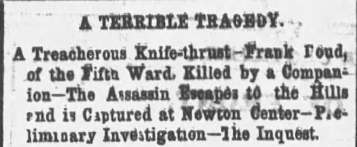
July 7, 1875
The news of this latest violence spread quickly throughout the country – with reports surfacing in several states, as far away as California!
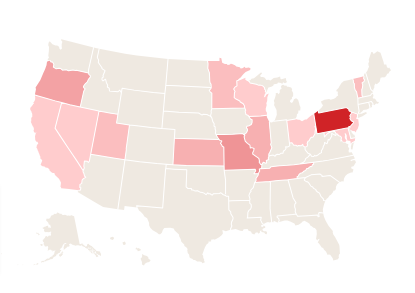
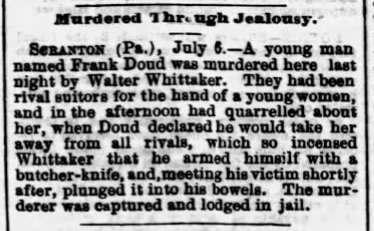
July 7, 1875
A Fight Breaks Out
On the morning of July 5, 1875, Frank Doud(Dowd) and Walter Whittaker were drinking together at the home of John McColligan on Washburn St. The two men were considered friends, but soon, they began to argue over a young woman whom Whittaker had been dating.
Doud said that he was going to steal the young woman away from Whittaker. This infuriated Whittaker – to the point that he said he would kill Doud. Later, Whittaker went home, grabbed a butcher knife that he hid in his boot, and returned to meet up with Doud.
The deadly encounter came in front of John Mulrooney’s home at 2016 Washburn St. The two men began to fight, with Doud apparently landing a punch that bloodied Whittaker’s mouth. After wrestling on the ground for a bit, the two separated and got back to their feet. That’s when Whittaker pulled the knife, plunged it into Doud’s abdomen, and took off running.
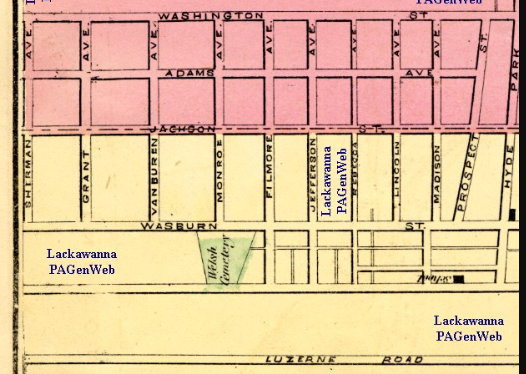
Map of Hyde Park
1873
Neighbors saw the confrontation and watched in horror as Doud rushed into Mulrooney’s home. A neighbor who witnessed the action, Farrell (aka Michael) Gannon, ran for Dr. Gulick and escorted him back to the Mulrooney home, where he rendered aid to Doud. The victim lay there for a while, but the prognosis was not good.

July 7, 1875
Later in the evening, Doud asked to be moved to his home near the Price St Mine Shafts – where he lived with his widowed mother. It was there that he passed away at 9:30 p.m.
The Manhunt
In the meantime, Whittaker was followed by a couple of neighbors, but he was able to evade capture after entering the woods. Concerned citizens scoured the woods and went from house to house in search of the murderer – with no luck.

July 8, 1875
Police went to Whittaker’s home on St. Mary’s Street (now Sherman Ave) and questioned his father, Richard Whittaker. After questioning, police detained Richard on conspiracy charges and put him in the Hyde Park lockup.
The next morning, as the hope of capturing Walter was diminishing, news came that two men who had trailed him all night were able to catch him in Newton Center. Two young men, Patrick Scott and John Caffrey, transported the suspect back to Scranton in a horse and buggy to face justice.
As they passed along Main Ave on their way to the jail where Richard was being held, the locals watched the procession with concern and anger.
Initial Testimony
Whittaker was immediately brought before Mayor Robert McKune for his initial hearing. During the testimony, Mary Ann McColligan, the daughter of the homeowner where the two men were drinking later in the day, testified that she heard them arguing and that, at one point, Whittaker had a chair in his hand and threatened to hit Doud. With that, Mary Ann and her mother told the two men to leave.
She said she saw Walter go to his house down the street and, shortly after, returned to the McColligan home. Mary Ann said when he came back, he showed her the knife and said that he was going to “stick” Frank. She asked him to give up the weapon, but Walter responded that he would – after he “ripped Frank from top to toe.”
After that, Walter left the McColligan home. The next time Mary Ann saw him was about 15 minutes later when he was running down Washburn St, followed by another man.
Farrell Gannon also testified that he knew the two men and saw them arguing. He watched from his home as a scuffle broke out. When the two let each other go, he saw Whittaker pull a knife and stab Doud.
It was then that Doud called out to Gannon that he was stabbed and that he needed a doctor.
That’s all the testimony that was needed to hold Walter over for trial.
Afterward, Walter’s father, Richard Whittaker, was released from prison due to lack of evidence of his involvement in the murder, but Walter was transferred to the jail in Wilkes-Barre. He pled not guilty – and was scheduled to stand trial.
Richard Whittaker
Richard’s freedom didn’t last long. Just two days after his initial release, he was sent back to prison. Once again, he was released due to lack of evidence.
Then again, in late November, for a third time, he was charged. After talking to more witnesses, officials now believed that he was indeed an accessory to the crime – both before and after the murder. He was accused of encouraging his son to fight for his girlfriend and then helping him to escape.

December 1, 1875
Witnesses testified that Mr. Whittaker said, “Doud has been interfering with my son and his girl, and anyone [who] interferes with my boy has got to die.”
While records are limited, I believe Richard was exonerated of his accusations and avoided any further jail time.
The Trial Begins

December 16, 1875
The case was heard in Wilkes-Barre in December 1875. District Attorneys Farnham and Connelly represented the Commonwealth, and Attorneys Palmer and Merrifield the defense.
DA Connelly addressed the jury and began to call witnesses.
Ann Gannon
The first witness called was Ann Gannon, wife of Farrell Gannon. She testified that she lived on Washburn Street. The Whittakers lived nearby on St. Mary’s Avenue (Sherman Avenue) at the bottom of Washburn Street. The Gannons operated a saloon in their home, and they knew both Walter and Frank as customers who lived in the area.
She said that on the morning of July 5, Walter Whittaker entered the saloon at about 9:00. He drank something, but she couldn’t recall what it was or how much he drank. He left shortly after.
She said that at about 2:00pm, Whittaker returned, followed shortly by Doud. The two were sitting on chairs near the door. They sat silent for about ten minutes. Then, Doud announced that he was going outside to have his beer. Whittaker followed.
Shortly after, she heard arguing. When she got outside, she saw Whittaker fall to the ground with Doud jumping on top of him. The two men struggled in a fight before separating and standing back on their feet. Walter had blood pouring out of his mouth. Then, Whittaker pulled the knife from his boot and lunged at Doud, plunging the blade into his stomach.
Doud staggered into John Mulrooney’s house as Whittaker took off running down the street holding a knife over his head – with a man chasing him.
Others were in the saloon at the time as well, including Michael Cawley and Walter’s father, Richard.
Mrs William Bachman
Mrs. Bachman testified that the day before, a sober Whittaker told Mrs. Bachman that his girlfriend, Mary Ann McNamara of Dunmore, had “gone back on me” and had given the ring he had given her to Frank.
She also testified that on the day of the murder, the two men had been in the front room of her house arguing over Miss McNamara. That’s when Whittaker picked a chair up over his head and told Doud that he could whip him any day of the week.
At that point, Mrs Bachman asked Whittaker to leave. In response, Walter laughed it off and said that it was all just fun.
After that exchange, Walter and her husband, William Bachman, left and went down to Walter’s house. When they returned, Walter showed her a knife and said that he would “rip Frank from tip to toe”, then he went outside again.
Mary Ann McColligan
Mrs. Bachman’s daughter, Mary Ann McColligan, corroborated much of what Mrs. Bachman had said. She was home at the same time. She added that both Doud and Whittaker appeared drunk. She said that after Whittaker left the home, he passed by his father and said, “See here, old man (showing him the knife), if anyone interferes with me, they will get this.”
Mary Ann’s stepfather, William Bachman, was also in the room when the two men were there.
William Bachman
Mr. Bachman was called to testify. He said about three weeks earlier, he heard Whittaker say that if Doud didn’t watch out, he’d “get a piece of steel.”
He was asked about the day of the murder – then, the trial had a moment of levity. Bachman basically said that he’s often drunk, and he was drunk on the day of the murder. He claimed that he doesn’t remember anything when he’s drunk. He added, “When I’m drunk, I might think everyone else was drunk.”
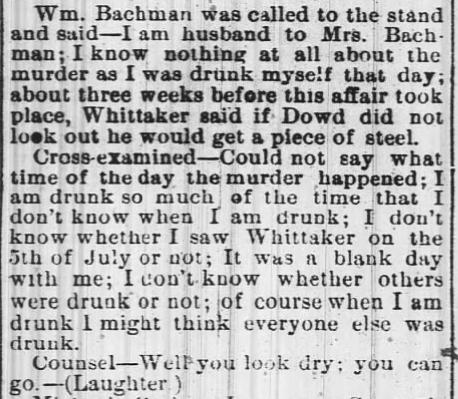
December 16, 1875
Mrs. John Mulrooney
Mrs. Mulrooney testified that Doud had been in the Mulrooney home just before the stabbing occurred. She said that he came in and that she, her husband, and Doud all had a drink together. Before Doud finished his drink, he left the Mulrooney home.
Farrell Gannon
Gannon testified that he had first seen Whittaker in the “forenoon” of July 5 at about 9:00 at a saloon on Main Avenue in Hyde Park. John Mulrooney was also with them. After that, Whittaker went to the Gannon home sometime between 12-2pm.
His testimony differed slightly from that of the young Mary Ann McColligan when he said that he didn’t believe that Whittaker nor Doud was drunk. He said both men seemed “peaceable and exhibited no bad blood towards each other.”
Mrs. Doud
Frank Doud’s mother testified. She said that Walter had come into her house on the day of the murder and said that he would not go to bed until he had killed a man that night.
Michael Harrison
Harrison lived on Jackson Street in Hyde Park. He testified that the two men got into an argument at about 11:00 p.m. on July 4, the night before the stabbing. Doud had pulled off his coat and wanted to fight Whittaker, but Walter would not oblige.
Harrison also said that he and Whittaker had a drink together at a saloon on Main Ave at about 9:00 a.m. on July 5th. After the drink, the two men walked up and down Main Avenue, and after that, he left Walter.
John Caffrey
John Caffrey, one of the two men to capture Walter, testified that when they caught him in Newton, Walter asked how Frank was doing. When told he was dead, Walter seemed remorseful but added that they couldn’t hang him because it wasn’t first-degree.
He added that a woman had given Walter a load of bread, and he told her that he was on his way to Ohio. When his captors asked about this, he told them that it was true and that he wasn’t looking forward to being in jail.
Caffrey said the two men were at his house the night of July 4, and Doud had brought some whiskey to drink. Everything seemed fine, and there were no words exchanged. Caffrey qualified his description of drunk, saying, “I don’t call a man drunk as long as he don’t stagger or fall.”
With that, the prosecution rests.
The Defense
After an opening statement by Attorney Merrifield, the defense began to call witnesses.
Mary Ann Whittaker
Walter’s mother began on behalf of her son. She testified that Walter had come home drunk at about 3:00 a.m. on July 5. He left again at about 8:00 a.m., then returned about two hours later – drunk again (or still?).
She said that William Bachman entered her home, a little drunk, and warned Walter about being killed. She added that she did not see or know of Walter taking a knife from the home.
Mary Ann said at one point, Walter had come home, and his face was bruised but not bloody. She said she specifically asked Walter if he had stabbed Frank, and his reply was, “Oh my God no, I could not have done it.”
It’s not clear to me when Walter would have entered back into his home with his face bruised. All other testimony has the two men fighting, then Walter immediately stabbing Frfank and then taking off into the woods.
Other Witnesses on Behalf of the Defense
Several other witnesses were deposed and provided testimony. Mrs. Fletcher said she heard Mrs. Mulrooney cursing at the time of the stabbing and that John Mulrooney had thrown a stone at Walter as he ran away.
J.B. Hickey testified that he saw Walter drunk on the day of the stabbing, while another man, John Anderson, saw Whittaker drinking that day.
Walter’s father, Richard, testified that Walter was very drunk that day. He added that he would have broken up the fight had he known the outcome would have been so severe.
Walter’s brother, John Whittaker, corroborated his father’s testimony and added that he told his brother to go away for two days.
Several other witnesses were brought on by the defense to speak of the good character of Walter Whittaker.
Reduction in Charges
After the defense rested, the DA said the State would only look for a conviction of second-degree murder, not first-degree. The DA also questioned some of the witnesses for the State – saying he believed they changed their testimony from the first time they were questioned about the facts of the case.
Verdict and Sentencing
With no time wasted and without ever leaving the jury box, the verdict was in. Guilty of murder of the second degree. The evidence was clear and overwhelming. Walter Whittaker would then be immediately sentenced to eleven years and ten months in prison for his crime.
Prison
Like other violent criminals from the area, Walter was sent to the notorious Eastern State Penitentiary. In 1884, he was listed as one of forty prisoners from Luzerne County who were being housed in the hardened Philadelphia prison. Each prisoner was costing the county nineteen cents per day – an unbelievably low $69.35 per year! Less than $2,200 in today’s dollars!
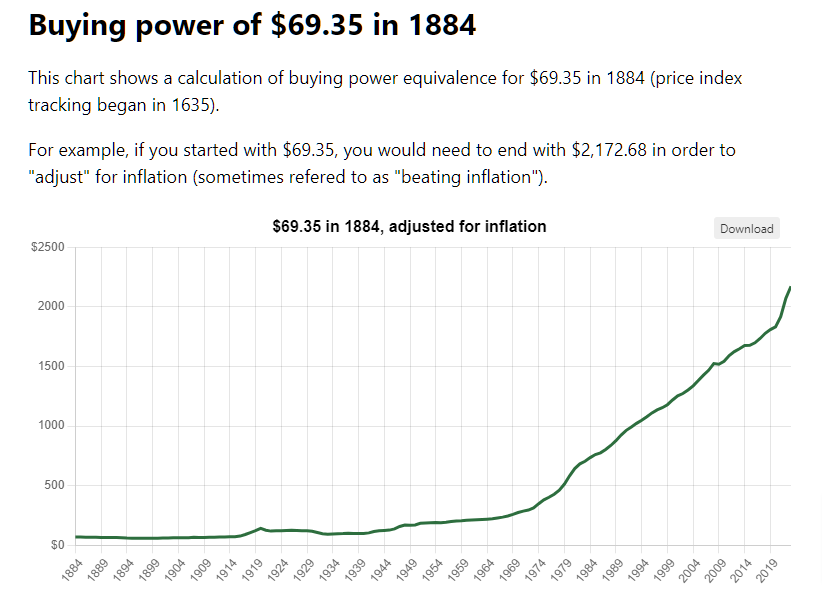
At the time, Walter was one of sixteen men from Luzerne County who were locked up on murder charges.
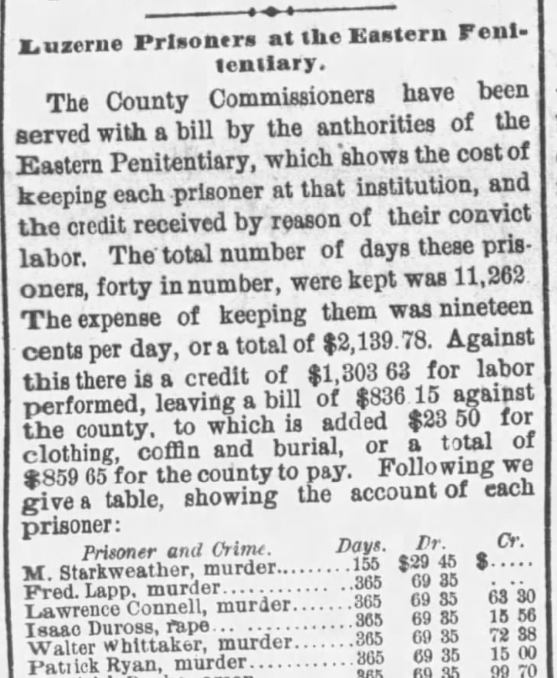
Records are sparse, but the best I can tell, he was still serving time as late as March 1886, over ten years after his initial 11-year and ten-month sentence.
In the article below, it appears that Walter was earning his keep while in jail. He was called out as being one of the few prisoners who was earning more money for his prison labor than his expenses were.
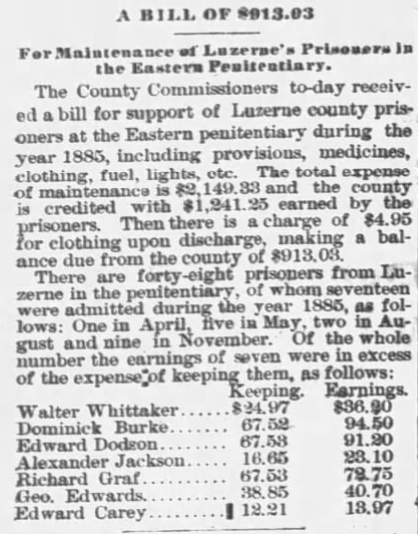
March 13, 1886
Legacy
It’s hard to tell what happened to the Whittaker and Doud families after this. The best I can tell, the Whittakers moved out of Scranton, and I can’t determine what happened to Mrs. Doud.
If any of the names in this story are familiar, let me know, and I can dig into it to see if I can help connect the dots.


